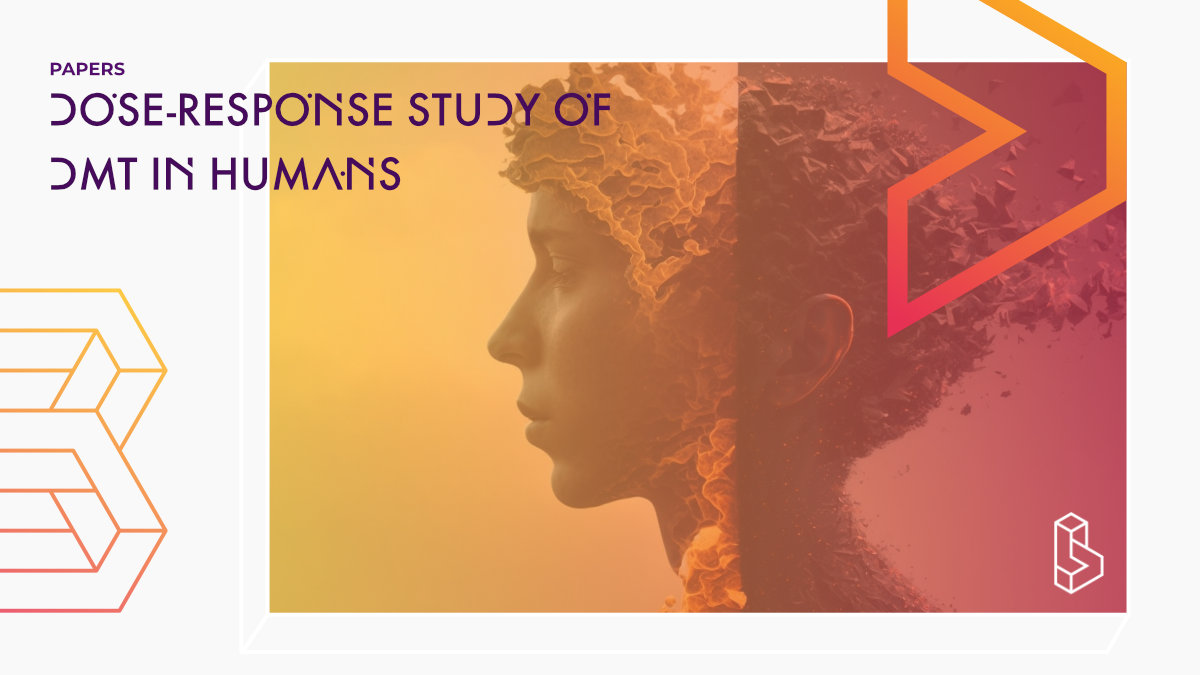This randomized, double-blind, placebo-controlled study (n=12) investigated the subjective effects of graded doses of DMT in hallucinogen-experienced users. Effects began almost immediately after DMT administration, peaking at 90 to 120 seconds, and were almost completely resolved by 30 minutes. Hallucinogenic effects were seen after 14 and 21 mg/70kg of DMT, while lower doses, 7 and 3.5 mg/70kg, were primarily affective and somaesthetic (body + sensory perception).
Abstract of Dose-response study of N,N-dimethyltryptamine in humans
“Background: Validation of animal models of hallucinogenic drugs’ subjective effects requires human data. Previous human studies used varied groups of subjects and assessment methods. Rating scales for hallucinogen effects emphasized psychodynamic principles or the drugs’ dysphoric properties. We describe the subjective effects of graded doses of N,N-dimethyltryptamine (DMT), an endogenous hallucinogen and drug of abuse, in a group of experienced hallucinogen users. We also present preliminary data from a new rating scale for these effects.
Methods: Twelve highly motivated volunteers received two doses (0.04 and 0.4 mg/kg) of intravenous (IV) dimethyltryptamine fumarate “nonblind,” before entering a doubleblind, saline placebo-controlled, randomized study using four doses of IV DMT. Subjects were carefully interviewed after resolution of drug effects, providing thorough and systematic descriptions of DMT’s effects. They also were administered a new instrument, the Hallucinogen Rating Scale (HRS). The HRS was drafted from interviews obtained from an independent sample of 19 experienced DMT users, and modified during early stages of the study.
Results: Psychological effects of IV DMT began almost immediately after administration, peaked at 90 to 120 seconds, and were almost completely resolved by 30 minutes. This time course paralleled DMT blood levels previously described. Hallucinogenic effects were seen after 0.2 and 0.4 mg/kg of dimethyltryptamine fumarate, and included a rapidly moving, brightly colored visual display of images. Auditory effects were less common. “Loss of control,” associated with a brief, but overwhelming “rush,” led to a dissociated state, where euphoria alternated or coexisted with anxiety. These effects completly replaced subjects’ previously ongoing mental experience and were more vivid and compelling than dreams or waking awareness. Lower doses, 0.1 and 0.05 mg/kg, were primarily affective and somaesthetic, while 0.1 mg/kg elicited the least desirable effects. Clustering of HRS items, using either a clinical, mental status method or principal components factor analysis provided better resolution of dose effects than did the biological variables described previously.
Conclusions: These clinical and preliminary quantitative data provide bases for further psychopharmacologic characterization of DMT’s properties in humans. They also may be used to compare the effects of other agents affecting relevant brain receptors in volunteer and psychiatric populations.”
Authors: Rick J. Strassman, Clifford R. Qualls, Eberhard H. Uhlenhuth & Robert Kellner
Summary of Dose-response study of DMT in humans
Previous human studies of hallucinogenic drugs’ subjective effects used varied groups of subjects and assessment methods. Strassman and colleagues present preliminary data for these effects from a new rating scale.
Twelve highly motivated volunteers received two doses of DMT intravenously non-blind and four doses in a double-blind, saline placebo-controlled, randomized study. They were interviewed and administered the Hallucinogen Rating Scale.
Find this paper
https://doi.org/10.1001/archpsyc.1994.03950020022002
Open Access | Google Scholar | Backup | 🕊
Cite this paper (APA)
Strassman, R. J., Qualls, C. R., Uhlenhuth, E. H., & Kellner, R. (1994). Dose-response study of N, N-dimethyltryptamine in humans: II. Subjective effects and preliminary results of a new rating scale. Archives of general psychiatry, 51(2), 98-108.
Authors
Authors associated with this publication with profiles on Blossom
Rick StrassmanRick Strassman is an associate professor of psychiatry and best known for his DMT research in the late 1990s and his subsequent book DMT: The Spirit Molecule.
Institutes
Institutes associated with this publication
University of New MexicoThis company doesn't have a full profile yet, it is linked to a clinical trial.
Compound Details
The psychedelics given at which dose and how many times
DMT 14 - 21mg | 6x

